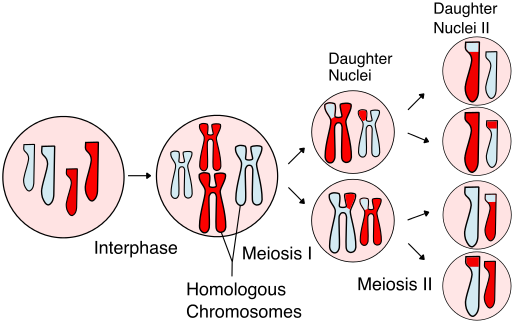Meiosis
Contents
Key Stage 4
Meaning
Meiosis is the process of asexual reproduction where a parent cell produces four haploid daughter cells known as gametes that are all genetically unique.
Noun: Meiosis
Adjective: Meiotic
About Meiosis
- Meiosis is how multicellular organisms (including humans) produce gametes for sexual reproduction.
- Meiotic cell division results in the production of 4 daughter cells which are all genetically different to each other.
- During meiotic cell division the nucleus divides into two separate diploid nuclei before dividing a second time to produce 4 haploid nuclei.
- The four daughter cells are called haploid cells because they contain half the number chromosomes needed to grow a new organism.
| A diagram showing the chromosomes during the process of meiosis. |
References
AQA
- Meiosis, page 208, GCSE Combined Science Trilogy; Biology, CGP, AQA
- Meiosis, page 253, GCSE Biology, CGP, AQA
- Meiosis, page 68, GCSE Combined Science; The Revision Guide, CGP, AQA
- Meiosis, page 88, GCSE Biology; The Revision Guide, CGP, AQA
- Meiosis, pages 180-2, GCSE Biology, Hodder, AQA
- Meiosis, pages 196, 198-199, 201, GCSE Biology; Third Edition, Oxford University Press, AQA
- Meiosis, pages 30-1, GCSE Combined Science Trilogy 2, Hodder, AQA
- Meiosis; Comparison with mitosis, pages 32, GCSE Combined Science Trilogy 2, Hodder, AQA
- Meiosis; How it produces variation, pages 32, GCSE Combined Science Trilogy 2, Hodder, AQA
Edexcel
- Meiosis, page 26, GCSE Combined Science; The Revision Guide, CGP, Edexcel
- Meiosis, page 32, GCSE Biology; The Revision Guide, CGP, Edexcel
- Meiosis, page 85, GCSE Biology, CGP, Edexcel
- Meiosis, pages 40-41, GCSE Combined Science, Pearson Edexcel
- Meiosis, pages 52-53, GCSE Biology, Pearson, Edexcel
